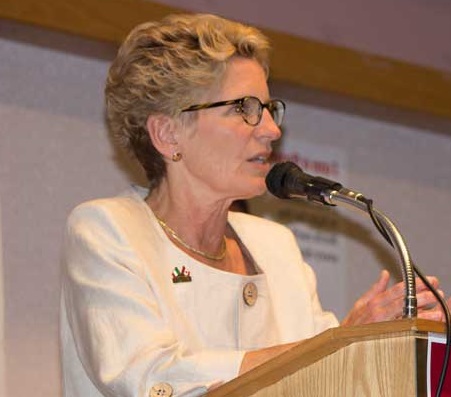
Ontario Premier Kathleen Wynne attended the opening of two professional programs in Northern Ontario on September 4th, as part of her commitment to help young people in every part of the province prepare for promising careers.
Lakehead University’s Faculty of Law in Thunder Bay and Laurentian University’s School of Architecture in Sudbury are Northern Ontario’s first law and architecture schools, and the first of their kinds to open in the province in more than 40 years.
The schools will help Northern Ontario students enter the law and architecture professions, and study closer to their families and the communities where they grew up. There is currently a shortage of lawyers who specialize in Northern issues, and Lakehead’s new law school will help bridge that gap by focusing on issues such as access to justice in Northern and rural communities, as well as Aboriginal, natural resource and small- or single-practitioner law.
The Ontario government is committed to making smart investments that will help Northern Ontario’s economy grow and create more jobs.
“I want young people in every part of this province to be able to pursue their
dreams, find great careers and give back to their communities. These two exciting
programs bring new opportunities to a wonderful part of our province.”
—Kathleen Wynne, Premier of Ontario
“A post-secondary education continues to be one of the most important investments
people can make in themselves and their future. Programs like these will help
prepare students in the North for the global economy, give them better access to
good jobs and help Ontario build the highly skilled and educated workforce it
needs.”
—Brad Duguid, Minister of Training, Colleges and Universities
“These two new programs further establish Thunder Bay and Sudbury as destinations
for specialized post-secondary education and training. Our government is so proud to
be able to work with educational institutions in Northern Ontario to ensure we have
the infrastructure needed to educate the workforce of tomorrow.”
—Michael Gravelle, Minister of Northern Development and Mines

QUICK FACTS
§ The Ontario government invested $1.5 million in Lakehead’s new Faculty of Law building, and $21 million in Laurentian’s new School of Architecture.
§ Approximately 57 per cent of Lakehead’s 60 new Faculty of Law students are from Northern Ontario. Laurentian’s inaugural School of Architecture class is comprised of 70 students.
§ Laurentian is the first Canadian school of architecture outside of Quebec to offer French programming. It also provides students with access to an Elder-in-residence, and several courses focused on Aboriginal teachings.
LEARN MORE
Find out more about Lakehead University’s Faculty of Law<https://www.lakeheadu.ca/academics/departments/law>.
Read more about Laurentian University’s School of Architecture<http://www.laurentian.ca/content/school-architecture-0>.
Disponible en français (Contacter le Silo)
Supplemental–http://news.ontario.ca/opo/en/2013/09/northern-ontarios-first-law-and-architecture-schools-open.html

Small school closures — an attack on rural Ontario

As a rural MPP I am the beneficiary of eight years of elementary education in a one-room school – S.S. #12 Shands, just north of Port Dover.
Like most, Shands School was small with eight grades and one teacher. I found it an excellent and cost-effective model – a model that continues today in parts of Canada and throughout much of the world.
Rural schools are often the backbone of communities where the young and young at heart, meet for reasons beyond schooling.
Administrators have long been eager to reform education by jamming kids into larger communities and large schools… super schools. School boards and the Ministry of Education do this under the guise of saving money and offering a better education. However, this is not often true. In fact, report after report debunks the argument of economies of scale and highlights increased absenteeism and dropout rates in large schools.
Across North America there are examples of school boards hastily closing small schools then realizing their mistake a few years later after urban sprawl, new industry and population growth bring back the original raison d’etre.
We know Ontario’s independent schools have a strong presence in rural areas and small towns. In fact, 30 per cent are operating areas with fewer than 30,000 citizens. Further, almost half of Ontario’s non-government schools have fewer than 50 students and more than a quarter educate between 50 and 149 students.
If more than three of every four independent schools in Ontario can exist with fewer than 150 students, without government funding, why are small schools not considered viable in public and Roman Catholic education?
The present government has allowed for a fast-tracking of the closure process and, currently, there are potentially 600 schools on the chopping block.
I have always rejected the blanket call for shuttering small schools and shipping out students. During Question Period on November 21st I had the opportunity to raise questions in the House as concerned parents, students and educators protested out front.
“Closing rural schools can have a dramatic impact on rural areas where the school is often the heart of the community,” I told the Premier. “The economic impact of closing a school in a rural area should always be considered, and yet the Ministry of Education has quietly removed the last two criteria to the PARG process that looks at value to the community and value to the local economy.” Haldimand-Norfolk MPP Toby Barrett
As parents sit through accommodation meetings, school board officials point the finger at the Ministry of Education, and yet last week the Minister of Education pointed back, saying she provides enough money to boards to keep small schools open. So who is to blame? Frankly, the current funding model appears rigged to not support the ongoing viability of small schools.
Parents, students and community leaders know when school buildings are boarded up, and students spend long hours busing to large population centres, rural areas become less attractive to families and businesses. My colleague MPP Jim McDonell has put forth a motion calling for a moratorium on school closures until a long-term plan is developed.
Schools can remain hubs of activity and community life that, in some cases, have marked our countryside for decades. Closing rural schools remains an ongoing attack on rural Ontario.